Wheel of Emotions
So in writing my speech for the upcoming Plektrum Festival in Tallinn, I've been thinking about AI, how the robots of sf go beyond the clockwork men a la Tik-Tok in the Oz books, Gort in The Day the Earth Stood Still, Robbie the Robot, etc., to become self-aware. Thinking about how artificial intelligence is really often artificial sentience, how even the ones that are supposed to be beings of pure intellect are actually sneakily emotional. Like, even before his emotion chip, Data exhibits curiosity, an affect; he has to, to function as a character.
Anyways, that got me thinking about affect. Been watching Lie To Me too, actually, in which Tim Roth plays a specialist in lie detection whose work turns on the identification of unconscious "micro-expressions," fleeting facial and gestural demonstrations of emotional states at odds with what someone is saying. (You could well call it a science fiction show on that basis, come to think of it, since it's riffing off the work of psychologist Paul Ekman in this field which even in itself sounds rather speculative.) So it focused me on the six basic expressions universally recognised across all cultures -- joy & sadness, anger & fear, disgust & surprise.
I've mused on these in the past as part of my interest in aesthetics -- by which I mean not the study of what Art is or what Beauty consists of, but the study of sensation itself. I'm deeply curious about the obvious pairings of joy & sadness and anger & fear. It's like, come on, there's clearly oppositional relationships here. And that makes me think dimensional relationships, which makes me think phase space. My time spent working in a thread dyers, learning a little colour physics, factors in here. Like, you know there are six primary colours, yes?
Six?! I hear you say, you physicists and painters. No, no, no, there's only three! Sorry, mate, if you think yellow is a mix of green and red or green is a mix of yellow and blue, you're wrong; that's a matter of how light and paint mix, not the constituent aesthemes of our sense of sight. There are six colours we perceive as discrete basic colours, from which all shades are constructed, these being locked into three opponent processes: red/green; yellow/blue; black/white. The three processes thus construct a 3D phase space of colour, a colourspace.
(Read that opponent process link for the wacky shit that happens if you fuck with the oppositional relationship preventing us from seeing a reddish green or a yellowish blue. I so want to take part in the experiment that allows me to see... The Colour Out of Colourspace!)
So, a while back I started wondering if affect could be thought of in these sort of terms. Here be a doodle of my vague thoughts:
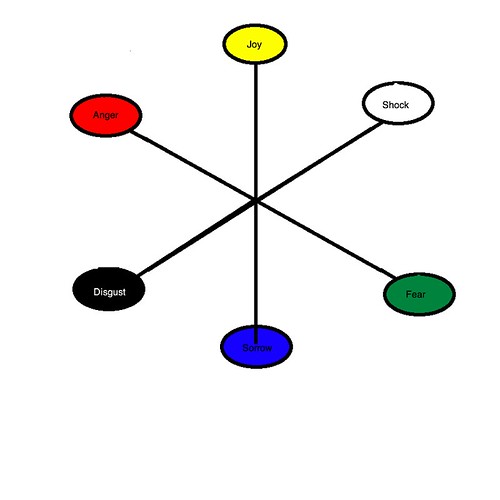
What's wrong with this picture is that you can, I'd say, experience a sort of happy sadness in the form of melancholy, so we can't actually be talking yellow/blue style opponent processes. And setting disgust and surprise in opposition like that is a stretch. I could maybe rationalise it as an axis of affects designed to engage with the world in terms of laws and violations of what is considered natural by those laws, but the two affects go together more often than they oppose each other, no? So, it's at best a cursory model.
Still, I've played around with this as a way of considering other emotions as the equivalents of secondary and tertiary colours -- i.e. as nominally labeled zones within that affectspace -- and even maybe mapping the axes to psychological complexes. Like, the way the notion of the Self is constructed as a relationship of me to myself ties it to that joy/sorrow axis, while the way we construct a notion of the Ego as a relationship of me to others ties it to the anger/fear axis that comes into play in defining relative social status -- dominance and submission. The surprise/disgust axis is odd man out here again, right enough, and the whole thing has always been kind of a mad pet theory that I'm quite aware likely reads as utterly crackpot reductionism to many. It's just a notion to play around with.
So it's kind of neat, when I start nosing around the idea of affect again recently, to discover that actual psychologists have applied pretty much the same approach. I'm validated! Yay! Because here's the Wheel of Emotion proposed by Robert Plutchik decades ago:

Neat, huh? And much prettier than mine, I freely admit. Back in 1980, he was already proposing what is basically an affectspace, with basic emotions in oppositional relationships and advanced emotions as composites of them.
And interestingly, his model adds to the Big Six in a way that balances it out. I'm not sure it totally works for me as is -- we'll come to that -- but where he adds in anticipation (with its milder form of interest) and trust (with its stronger form of admiration,) it turns out this is reflected in more recent developments in the field where other emotions like elevation, interest, gratitude, confusion and pride have been suggested as deserving of a similar fundamental status.
I look at that model and it doesn't quite satisfy me though. Some of the choices don't really gel with me -- like vigilance -- in what's basically a 2D plane with an added dimension of intensity, it seems the mixing is limited to the overlap of adjacent emotions. To me, in fact, interest/anticipation and apprehension/fear look a lot more like they should be adjacent than fear and trust. Emotions of caution and curiosity belong together, it seems to me, as do the "up" emotions of ecstasy and admiration, and the "down" emotions of sadness and disgust. If we see anger and surprise as knitted together -- responses that articulate profound disruption -- maybe we have a deeper order of four pairs of axes... or even two pairs of pairs.
So, I'm thinking you have the anger/fear and trust/disgust axes as one 2D plane of emotions involving a sort of projection -- distinctly related to an exterior object -- and suprise/interest and joy/sadness axes as another plane of emotions involving immersion. And each has its horizontal axis running from emotions of violation (rage & amazement) to emotions of captivation (terror & vigilance[?],) and its vertical axis running from elevation (admiration[?] & ecstasy) to depression (loathing & grief.) Like this:
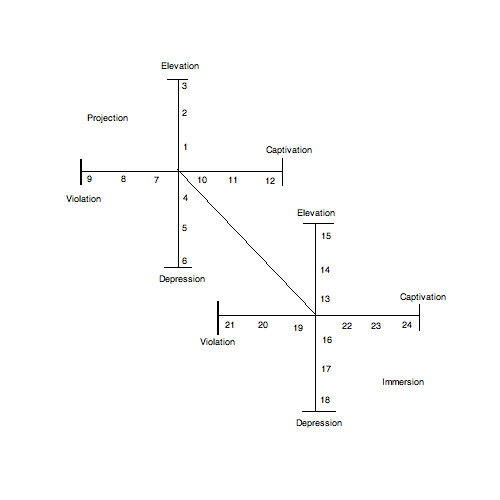
The numbers represent Plutchik's emotions... or rather they mostly represent Plutchik's emotions, with a few tweaks here and there. By twisting one plane 45° and superimposing it, you can reconstruct the wheel of emotions so it reflects those three dimensions of elevation/depression, violation/captivation and projection/immersion:
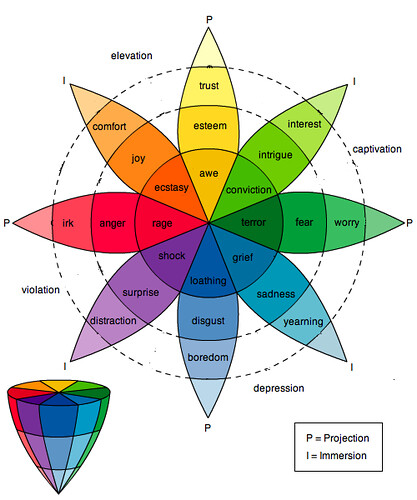
You'll notice a few renamings, and the colour-coding has changed quite a bit, but this feels more right to me. As I say, there are three oppositions at play here: elevation/depression; violation/captivation; projection/immersion. The first speaks for itself. The second is a matter of attention agitated or transfixed. With the third... what exactly do I mean by projection and immersion? What I'm thinking is that in their evaluative action, anger/fear and esteem/disgust dissociate the object of the emotion from the individual experiencing it. Even directed at oneself, it is an evaluation that objectifies oneself, judges as from outside. With joy/sadness the emotion is an assertion of identity when self-directed, and when directed at an object, like intrigue/suprise, it reinforces the individual's sense of connection with it. One might view the projection affects as alienated versions of the immersion affects (i.e. worry is alienated interest, esteem is alienated joy.)
Anyway here's the breakdown of emotions as I've tweaked them from Plutchik's original, with explanations of my reasoning.
Projective Elevation
1. Acceptance -> Trust
2. Trust [Plutchik] -> Esteem
3. Admiration [Plutchik] -> Awe
Plutchik's chosen rather lukewarm affects here, it seems to me, with trust implying simply a lesse general mode of acceptance -- that some particular thing is of neutral/positive value -- rather than an active positive valuation. Admiration meanwhile is really not comparable in intensity to emotions like loathing, rage, ecstasy and terror. So I'm bumping everything up a notch here. The peak state might equally be described as reverence or wonder -- if the latter doesn't imply an element of surprise via its connotation of disbelief. If you think of awe as implying an element of fear, you might well prefer to label this reverence.
Projective Depression
4. Boredom
5. Disgust
6. Loathing
Projective Violation
7. Annoyance [Plutchik] -> Irk
8. Anger
9. Rage
"Irk" is a better word. It just is. It's like an ickle ire, irk, as at the irksome quirk of some berk of a jerk. Irk. Honestly, "annoyance" is just rubbish.
Projective Captivation
10. Apprehension [Plutchik] -> Worry
11. Fear
12. Terror
"Worry" is also a better word, but here it's more because I think it gives a generality, in the way you can "worry" at something there in front of you. It lessens the sense of expectation of a particular future event -- i.e. the intellectual element of foresight -- and focuses more on the affective state, to my mind.
Immersive Elevation
13. Serenity [Plutchik] -> Comfort
14. Joy
15. Ecstasy
"Serenity" is rather too strong, implying blissful tranquility rather than mild pleasure.
Immersive Depression
16. Pensiveness -> Yearning
17. Sadness
18. Grief
Introspection is an action, not an emotional state. To be pensive is simply to ponder, to be engaged in serious thought. I think we might better define the mild form of sadness as the sense of pleasure's absence, the point where diminished comfort becomes perceptible as a loss.
Immersive Violation
19. Distraction
20. Surprise
21. Amazement [Plutchik] -> Shock
Again, "amazement" is inadequate, to my mind. The extremes of rage, loathing, ecstasy and terror are hysterical, likewise awe. Shock makes more sense here. We should, I think, be able to bind the peak emotions to pathological dysfunctions.
Immersive Captivation
22. Interest
23. Anticipation [Plutchik] -> Intrigue
24. Vigilance [Plutchik] -> Conviction
Anticipation and vigilance are not basic emotions, I'd say, but loaded with joy and/or worry and again, like apprehension, involve an element of foresight -- i.e. they're expectational. The alertness Plutchik is focusing on seems a more kinaesthetic state to me, in fact. I think a more obvious intensification of interest lies in intrigue. This is the state of having one's attention seduced, a raptness which becomes, at its extreme, compulsively committed, unbreakable -- conviction.
Anyways, that's my take on Plutchik's Wheel of Emotions. I kind of like my colour-coding more too, I have to say. We've got the right emotions for "feeling blue," and those bright warm oranges and yellows associated with elevation affects. If green doesn't particularly associate with captivation states, they are at least bound together by it in the diagram. Red stays with anger, as is only logical. And I rather like the way the purple of surprise refuses to blend.
And now, I'm beginning to think of just how I might start to correlate this with the notion of narrative modalities, with boulomaic modalities, numina and monstra, associating with elevation and depression affects (the latter perhaps also with violation affects,) and with captivation affects linking to the credibility and determinacy warp born of alethic and epistemic modalities. I fancy a link might also be made between deontic modalities and projection.
Which may of course be of interest only to me, but hey, as I said at the start, curiosity is an emotion, and apparently I'm rather driven by it. Captivated, you might say.
Anyways, that got me thinking about affect. Been watching Lie To Me too, actually, in which Tim Roth plays a specialist in lie detection whose work turns on the identification of unconscious "micro-expressions," fleeting facial and gestural demonstrations of emotional states at odds with what someone is saying. (You could well call it a science fiction show on that basis, come to think of it, since it's riffing off the work of psychologist Paul Ekman in this field which even in itself sounds rather speculative.) So it focused me on the six basic expressions universally recognised across all cultures -- joy & sadness, anger & fear, disgust & surprise.
I've mused on these in the past as part of my interest in aesthetics -- by which I mean not the study of what Art is or what Beauty consists of, but the study of sensation itself. I'm deeply curious about the obvious pairings of joy & sadness and anger & fear. It's like, come on, there's clearly oppositional relationships here. And that makes me think dimensional relationships, which makes me think phase space. My time spent working in a thread dyers, learning a little colour physics, factors in here. Like, you know there are six primary colours, yes?
Six?! I hear you say, you physicists and painters. No, no, no, there's only three! Sorry, mate, if you think yellow is a mix of green and red or green is a mix of yellow and blue, you're wrong; that's a matter of how light and paint mix, not the constituent aesthemes of our sense of sight. There are six colours we perceive as discrete basic colours, from which all shades are constructed, these being locked into three opponent processes: red/green; yellow/blue; black/white. The three processes thus construct a 3D phase space of colour, a colourspace.
(Read that opponent process link for the wacky shit that happens if you fuck with the oppositional relationship preventing us from seeing a reddish green or a yellowish blue. I so want to take part in the experiment that allows me to see... The Colour Out of Colourspace!)
So, a while back I started wondering if affect could be thought of in these sort of terms. Here be a doodle of my vague thoughts:

What's wrong with this picture is that you can, I'd say, experience a sort of happy sadness in the form of melancholy, so we can't actually be talking yellow/blue style opponent processes. And setting disgust and surprise in opposition like that is a stretch. I could maybe rationalise it as an axis of affects designed to engage with the world in terms of laws and violations of what is considered natural by those laws, but the two affects go together more often than they oppose each other, no? So, it's at best a cursory model.
Still, I've played around with this as a way of considering other emotions as the equivalents of secondary and tertiary colours -- i.e. as nominally labeled zones within that affectspace -- and even maybe mapping the axes to psychological complexes. Like, the way the notion of the Self is constructed as a relationship of me to myself ties it to that joy/sorrow axis, while the way we construct a notion of the Ego as a relationship of me to others ties it to the anger/fear axis that comes into play in defining relative social status -- dominance and submission. The surprise/disgust axis is odd man out here again, right enough, and the whole thing has always been kind of a mad pet theory that I'm quite aware likely reads as utterly crackpot reductionism to many. It's just a notion to play around with.
So it's kind of neat, when I start nosing around the idea of affect again recently, to discover that actual psychologists have applied pretty much the same approach. I'm validated! Yay! Because here's the Wheel of Emotion proposed by Robert Plutchik decades ago:

Neat, huh? And much prettier than mine, I freely admit. Back in 1980, he was already proposing what is basically an affectspace, with basic emotions in oppositional relationships and advanced emotions as composites of them.
And interestingly, his model adds to the Big Six in a way that balances it out. I'm not sure it totally works for me as is -- we'll come to that -- but where he adds in anticipation (with its milder form of interest) and trust (with its stronger form of admiration,) it turns out this is reflected in more recent developments in the field where other emotions like elevation, interest, gratitude, confusion and pride have been suggested as deserving of a similar fundamental status.
I look at that model and it doesn't quite satisfy me though. Some of the choices don't really gel with me -- like vigilance -- in what's basically a 2D plane with an added dimension of intensity, it seems the mixing is limited to the overlap of adjacent emotions. To me, in fact, interest/anticipation and apprehension/fear look a lot more like they should be adjacent than fear and trust. Emotions of caution and curiosity belong together, it seems to me, as do the "up" emotions of ecstasy and admiration, and the "down" emotions of sadness and disgust. If we see anger and surprise as knitted together -- responses that articulate profound disruption -- maybe we have a deeper order of four pairs of axes... or even two pairs of pairs.
So, I'm thinking you have the anger/fear and trust/disgust axes as one 2D plane of emotions involving a sort of projection -- distinctly related to an exterior object -- and suprise/interest and joy/sadness axes as another plane of emotions involving immersion. And each has its horizontal axis running from emotions of violation (rage & amazement) to emotions of captivation (terror & vigilance[?],) and its vertical axis running from elevation (admiration[?] & ecstasy) to depression (loathing & grief.) Like this:

The numbers represent Plutchik's emotions... or rather they mostly represent Plutchik's emotions, with a few tweaks here and there. By twisting one plane 45° and superimposing it, you can reconstruct the wheel of emotions so it reflects those three dimensions of elevation/depression, violation/captivation and projection/immersion:

You'll notice a few renamings, and the colour-coding has changed quite a bit, but this feels more right to me. As I say, there are three oppositions at play here: elevation/depression; violation/captivation; projection/immersion. The first speaks for itself. The second is a matter of attention agitated or transfixed. With the third... what exactly do I mean by projection and immersion? What I'm thinking is that in their evaluative action, anger/fear and esteem/disgust dissociate the object of the emotion from the individual experiencing it. Even directed at oneself, it is an evaluation that objectifies oneself, judges as from outside. With joy/sadness the emotion is an assertion of identity when self-directed, and when directed at an object, like intrigue/suprise, it reinforces the individual's sense of connection with it. One might view the projection affects as alienated versions of the immersion affects (i.e. worry is alienated interest, esteem is alienated joy.)
Anyway here's the breakdown of emotions as I've tweaked them from Plutchik's original, with explanations of my reasoning.
Projective Elevation
1. Acceptance -> Trust
2. Trust [Plutchik] -> Esteem
3. Admiration [Plutchik] -> Awe
Plutchik's chosen rather lukewarm affects here, it seems to me, with trust implying simply a lesse general mode of acceptance -- that some particular thing is of neutral/positive value -- rather than an active positive valuation. Admiration meanwhile is really not comparable in intensity to emotions like loathing, rage, ecstasy and terror. So I'm bumping everything up a notch here. The peak state might equally be described as reverence or wonder -- if the latter doesn't imply an element of surprise via its connotation of disbelief. If you think of awe as implying an element of fear, you might well prefer to label this reverence.
Projective Depression
4. Boredom
5. Disgust
6. Loathing
Projective Violation
7. Annoyance [Plutchik] -> Irk
8. Anger
9. Rage
"Irk" is a better word. It just is. It's like an ickle ire, irk, as at the irksome quirk of some berk of a jerk. Irk. Honestly, "annoyance" is just rubbish.
Projective Captivation
10. Apprehension [Plutchik] -> Worry
11. Fear
12. Terror
"Worry" is also a better word, but here it's more because I think it gives a generality, in the way you can "worry" at something there in front of you. It lessens the sense of expectation of a particular future event -- i.e. the intellectual element of foresight -- and focuses more on the affective state, to my mind.
Immersive Elevation
13. Serenity [Plutchik] -> Comfort
14. Joy
15. Ecstasy
"Serenity" is rather too strong, implying blissful tranquility rather than mild pleasure.
Immersive Depression
16. Pensiveness -> Yearning
17. Sadness
18. Grief
Introspection is an action, not an emotional state. To be pensive is simply to ponder, to be engaged in serious thought. I think we might better define the mild form of sadness as the sense of pleasure's absence, the point where diminished comfort becomes perceptible as a loss.
Immersive Violation
19. Distraction
20. Surprise
21. Amazement [Plutchik] -> Shock
Again, "amazement" is inadequate, to my mind. The extremes of rage, loathing, ecstasy and terror are hysterical, likewise awe. Shock makes more sense here. We should, I think, be able to bind the peak emotions to pathological dysfunctions.
Immersive Captivation
22. Interest
23. Anticipation [Plutchik] -> Intrigue
24. Vigilance [Plutchik] -> Conviction
Anticipation and vigilance are not basic emotions, I'd say, but loaded with joy and/or worry and again, like apprehension, involve an element of foresight -- i.e. they're expectational. The alertness Plutchik is focusing on seems a more kinaesthetic state to me, in fact. I think a more obvious intensification of interest lies in intrigue. This is the state of having one's attention seduced, a raptness which becomes, at its extreme, compulsively committed, unbreakable -- conviction.
Anyways, that's my take on Plutchik's Wheel of Emotions. I kind of like my colour-coding more too, I have to say. We've got the right emotions for "feeling blue," and those bright warm oranges and yellows associated with elevation affects. If green doesn't particularly associate with captivation states, they are at least bound together by it in the diagram. Red stays with anger, as is only logical. And I rather like the way the purple of surprise refuses to blend.
And now, I'm beginning to think of just how I might start to correlate this with the notion of narrative modalities, with boulomaic modalities, numina and monstra, associating with elevation and depression affects (the latter perhaps also with violation affects,) and with captivation affects linking to the credibility and determinacy warp born of alethic and epistemic modalities. I fancy a link might also be made between deontic modalities and projection.
Which may of course be of interest only to me, but hey, as I said at the start, curiosity is an emotion, and apparently I'm rather driven by it. Captivated, you might say.
Labels: philosophy





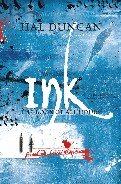


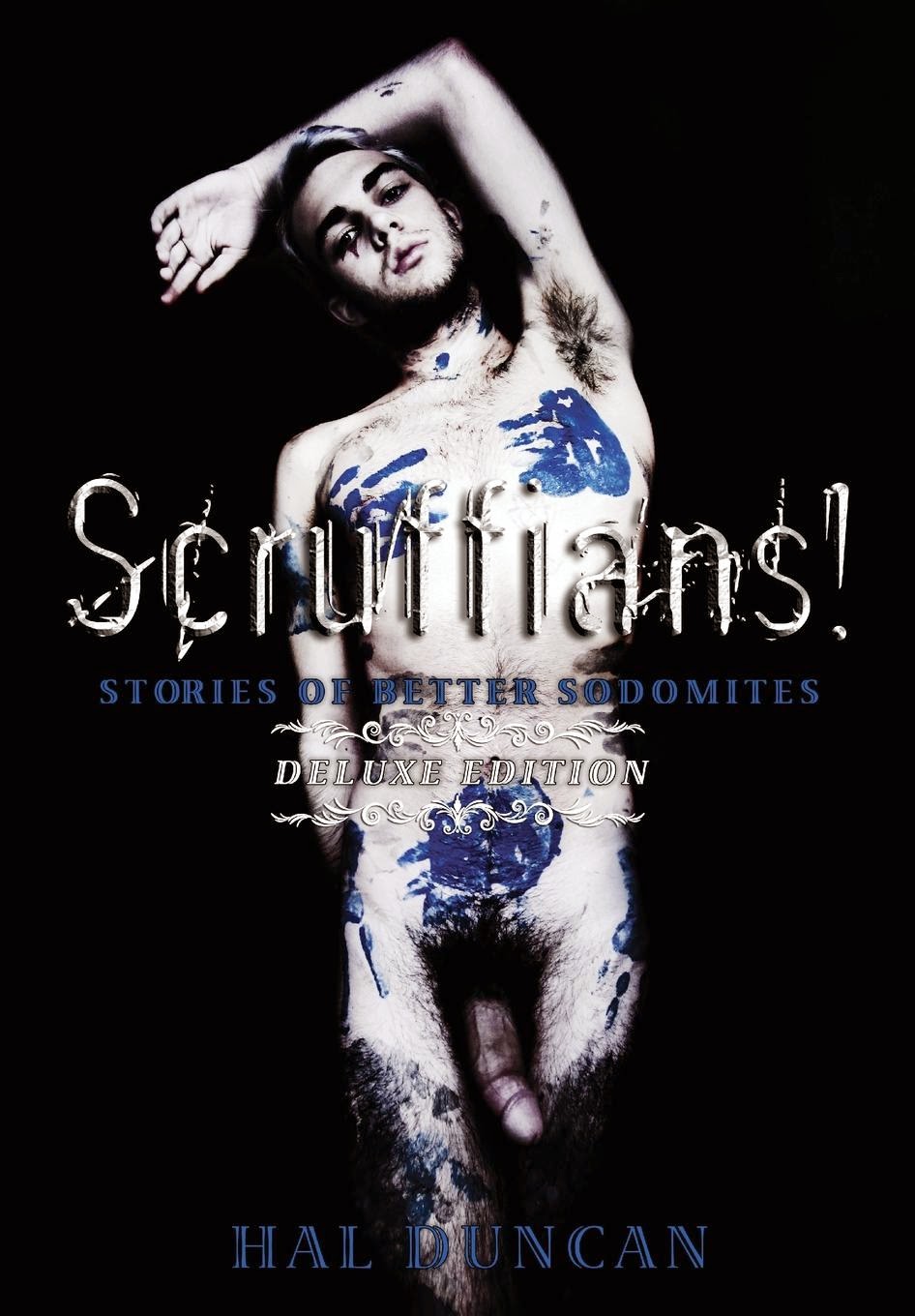















3 Comments:
I found Plutchik's diagram on a message/image board and saved it out of interest, without knowing what it was, so it's kind of fascinating to see it turn up here. Thanks for the enlightenment.
Also, since I can't seem to find the relevant link, if someone wanted to send you an email, which would be the best way to go about it?
The photo links to my blogspot profile page, and there's email contact details there. (I should probably make the link a bit more obvious, right enough.)
Anyhoo, it's: hal[AT]halduncan[PERIOD]com
Ah, cheers for that. I thought it'd be something along those lines, but I did want to make sure.
Post a Comment
<< Home